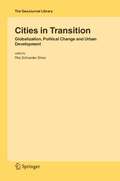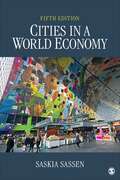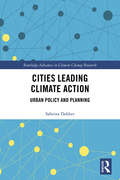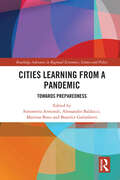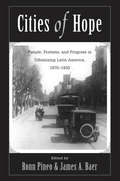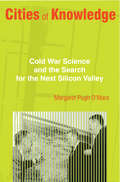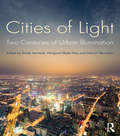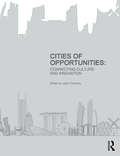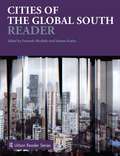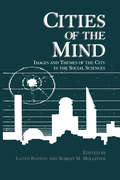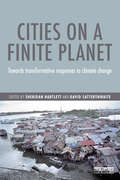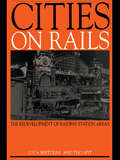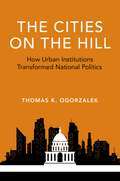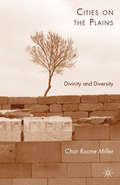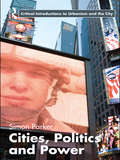- Table View
- List View
Cities in Transition: Globalization, Political Change and Urban Development (GeoJournal Library #83)
by Rita Schneider-SliwaThis book was written with the aim of showing that even in the era of globalization developments appearing in cities are not subject to almost unconditional global forces. Rather, universal forces are decisive eventualities in the process of urban restructuring, often influencing its course and speed, yet developments and particularities within a city strongly influence the course of events and the extent to which negative characteristics of globalization might occur. Berlin, Brussels, Hanoi, Ho Chi Minh City, Hong Kong, Jerusalem, Johannesburg, Moscow, St. Petersburg, Sarajevo and Vienna: Using these important cities the special relationship between global and local/regional forces is analyzed. The case studies were selected based on their political and cultural context and the fact that their social and political fabric was subject to major changes in the recent past. How global processes manifest themselves locally depends to a great extent on how development processes and endogenic potentials are initiated locally in order to cope with the new global economic and societal conditions.
Cities Leading Climate Action: Urban Policy and Planning (Routledge Advances in Climate Change Research)
by Sabrina DekkerThis book provides local governments and interested stakeholders with insights into the challenges and opportunities inherent in addressing climate change. Drawing on in-depth case study research on Vancouver, Portland, Glasgow and Dublin, Dekker examines the policy development processes employed by urban policy makers to respond to climate change, looking specifically at the utilisation of collaborative planning. Emerging from the case studies are lessons for local governments in relation to the role of organisational structure in supporting climate leadership; the importance of leadership, trust, relationship building and narratives for supporting ownership of the responses to climate change by stakeholders; and the need for creative and innovative public engagement to expand the reach of traditional methods such as social media and other technology-based solutions. Finally, Dekker reflects on her experience in the development of climate change action plans for the Dublin Local Authorities. This book will be of great relevance to students, scholars and policy makers with an interest in climate change resilience, environmental policy and urban planning.
Cities Leading Climate Action: Urban Policy and Planning (Routledge Advances in Climate Change Research)
by Sabrina DekkerThis book provides local governments and interested stakeholders with insights into the challenges and opportunities inherent in addressing climate change. Drawing on in-depth case study research on Vancouver, Portland, Glasgow and Dublin, Dekker examines the policy development processes employed by urban policy makers to respond to climate change, looking specifically at the utilisation of collaborative planning. Emerging from the case studies are lessons for local governments in relation to the role of organisational structure in supporting climate leadership; the importance of leadership, trust, relationship building and narratives for supporting ownership of the responses to climate change by stakeholders; and the need for creative and innovative public engagement to expand the reach of traditional methods such as social media and other technology-based solutions. Finally, Dekker reflects on her experience in the development of climate change action plans for the Dublin Local Authorities. This book will be of great relevance to students, scholars and policy makers with an interest in climate change resilience, environmental policy and urban planning.
Cities Learning from a Pandemic: Towards Preparedness (Routledge Advances in Regional Economics, Science and Policy)
by Simonetta Armondi Alessandro Balducci Martina Bovo Beatrice GalimbertiCOVID-19 has stressed the condition of radical uncertainty that increasingly characterises our times and compels cities to learn new ways to cope with unexpected global urban challenges. The volume proposes preparedness as a key concept in urban geography, planning, and policy, inviting international scholars to discuss its pros and cons. Firstly, it builds a critical theoretical framework around the concept of preparedness in relation to the COVID-19 effects and other interconnected crises. Then, the authors put at work and redefine preparedness, starting from worldwide surveys, research experiences, public discourses and spatial strategies analysis in Europe and, more extensively, in Italy. Finally, the closing section goes beyond the view of preparedness as an emergency tool, proposing to interpret it more broadly as a technology supporting a sustainable urban transition. The book mainly targets academics in urban planning, policy, and geography. However, the prominence of the topic of preparedness makes the volume an essential reading not only within social sciences but further in engineering, basic sciences, and life science. In addition, the book provides directions to practitioners and civic leaders in supporting cities and regions to prepare themselves in the face of pandemics and unpredictable socio-environmental shocks.
Cities Learning from a Pandemic: Towards Preparedness (Routledge Advances in Regional Economics, Science and Policy)
by Simonetta Armondi Alessandro Balducci Martina Bovo Beatrice GalimbertiCOVID-19 has stressed the condition of radical uncertainty that increasingly characterises our times and compels cities to learn new ways to cope with unexpected global urban challenges. The volume proposes preparedness as a key concept in urban geography, planning, and policy, inviting international scholars to discuss its pros and cons. Firstly, it builds a critical theoretical framework around the concept of preparedness in relation to the COVID-19 effects and other interconnected crises. Then, the authors put at work and redefine preparedness, starting from worldwide surveys, research experiences, public discourses and spatial strategies analysis in Europe and, more extensively, in Italy. Finally, the closing section goes beyond the view of preparedness as an emergency tool, proposing to interpret it more broadly as a technology supporting a sustainable urban transition. The book mainly targets academics in urban planning, policy, and geography. However, the prominence of the topic of preparedness makes the volume an essential reading not only within social sciences but further in engineering, basic sciences, and life science. In addition, the book provides directions to practitioners and civic leaders in supporting cities and regions to prepare themselves in the face of pandemics and unpredictable socio-environmental shocks.
Cities Of Hope: People, Protests, And Progress In Urbanizing Latin America, 1870-1930
by Ronn F PineoThis book brings together new research, analysis, and comparison on the dawn of modern urbanization in late-nineteenth- and early-twentieth-century Latin America. It offers a sense of what life was like for the urban residents examining the conditions they confronted and exploring their experiences.
Cities Of Hope: People, Protests, And Progress In Urbanizing Latin America, 1870-1930
by Ronn F PineoThis book brings together new research, analysis, and comparison on the dawn of modern urbanization in late-nineteenth- and early-twentieth-century Latin America. It offers a sense of what life was like for the urban residents examining the conditions they confronted and exploring their experiences.
Cities of Knowledge: Cold War Science and the Search for the Next Silicon Valley
by Margaret Pugh O'MaraWhat is the magic formula for turning a place into a high-tech capital? How can a city or region become a high-tech powerhouse like Silicon Valley? For over half a century, through boom times and bust, business leaders and politicians have tried to become "the next Silicon Valley," but few have succeeded. This book examines why high-tech development became so economically important late in the twentieth century, and why its magic formula of people, jobs, capital, and institutions has been so difficult to replicate. Margaret O'Mara shows that high-tech regions are not simply accidental market creations but "cities of knowledge"--planned communities of scientific production that were shaped and subsidized by the original venture capitalist, the Cold War defense complex. At the heart of the story is the American research university, an institution enriched by Cold War spending and actively engaged in economic development. The story of the city of knowledge broadens our understanding of postwar urban history and of the relationship between civil society and the state in late twentieth-century America. It leads us to further redefine the American suburb as being much more than formless "sprawl," and shows how it is in fact the ultimate post-industrial city. Understanding this history and geography is essential to planning for the future of the high-tech economy, and this book is must reading for anyone interested in building the next Silicon Valley.
Cities of Knowledge: Cold War Science and the Search for the Next Silicon Valley (PDF)
by Margaret Pugh O'MaraWhat is the magic formula for turning a place into a high-tech capital? How can a city or region become a high-tech powerhouse like Silicon Valley? For over half a century, through boom times and bust, business leaders and politicians have tried to become "the next Silicon Valley," but few have succeeded. This book examines why high-tech development became so economically important late in the twentieth century, and why its magic formula of people, jobs, capital, and institutions has been so difficult to replicate. Margaret O'Mara shows that high-tech regions are not simply accidental market creations but "cities of knowledge"--planned communities of scientific production that were shaped and subsidized by the original venture capitalist, the Cold War defense complex. At the heart of the story is the American research university, an institution enriched by Cold War spending and actively engaged in economic development. The story of the city of knowledge broadens our understanding of postwar urban history and of the relationship between civil society and the state in late twentieth-century America. It leads us to further redefine the American suburb as being much more than formless "sprawl," and shows how it is in fact the ultimate post-industrial city. Understanding this history and geography is essential to planning for the future of the high-tech economy, and this book is must reading for anyone interested in building the next Silicon Valley.
Cities of Light: Two Centuries of Urban Illumination
by Sandy Isenstadt Margaret Maile Petty Dietrich NeumannCities of Light is the first global overview of modern urban illumination, a development that allows human wakefulness to colonize the night, doubling the hours available for purposeful and industrious activities. Urban lighting is undergoing a revolution due to recent developments in lighting technology, and increased focus on sustainability and human-scaled environments. Cities of Light is expansive in coverage, spanning two centuries and touching on developments on six continents, without diluting its central focus on architectural and urban lighting. Covering history, geography, theory, and speculation in urban lighting, readers will have numerous points of entry into the book, finding it easy to navigate for a quick reference and or a coherent narrative if read straight through. With chapters written by respected scholars and highly-regarded contemporary practitioners, this book will delight students and practitioners of architectural and urban history, area and cultural studies, and lighting design professionals and the institutional and municipal authorities they serve. At a moment when the entire world is being reshaped by new lighting technologies and new design attitudes, the longer history of urban lighting remains fragmentary. Cities of Light aims to provide a global framework for historical studies of urban lighting and to offer a new perspective on the fast-moving developments of lighting today.
Cities of Light: Two Centuries of Urban Illumination
by Sandy Isenstadt Margaret Maile Petty Dietrich NeumannCities of Light is the first global overview of modern urban illumination, a development that allows human wakefulness to colonize the night, doubling the hours available for purposeful and industrious activities. Urban lighting is undergoing a revolution due to recent developments in lighting technology, and increased focus on sustainability and human-scaled environments. Cities of Light is expansive in coverage, spanning two centuries and touching on developments on six continents, without diluting its central focus on architectural and urban lighting. Covering history, geography, theory, and speculation in urban lighting, readers will have numerous points of entry into the book, finding it easy to navigate for a quick reference and or a coherent narrative if read straight through. With chapters written by respected scholars and highly-regarded contemporary practitioners, this book will delight students and practitioners of architectural and urban history, area and cultural studies, and lighting design professionals and the institutional and municipal authorities they serve. At a moment when the entire world is being reshaped by new lighting technologies and new design attitudes, the longer history of urban lighting remains fragmentary. Cities of Light aims to provide a global framework for historical studies of urban lighting and to offer a new perspective on the fast-moving developments of lighting today.
Cities of Opportunities: Connecting Culture and Innovation
by Jason PomeroyCulture refers to not only the arts but also other manifestations of human intellectual achievement regarded collectively. It similarly refers to the customs, institutions, and achievements of a social group, a people, or a nation. Innovation refers to the action or process of change, alteration, or revolution; a new method of idea creation or product that may bring about change. It is easy to assume that innovation may be juxtaposed to the preservation of culture and time-tested rituals. Yet as human settlements grew; and as streets and squares evolved through the diverse exchanges of people trading, celebrating, rallying and socially interacting, it should come as little surprise that cities and its places would become, and continue to be, centres of culture and innovation that can be inextricably linked. Culture and Innovation in cities can potentially take on different complexions if viewed through the lens of academics and practitioners drawn from different geographies, disciplines, or fields of expertise when addressing particular urban challenges. It is through this complexity of views that this book seeks to provide a broad perspective on culture and innovation in the context of global cities today; and a rich cornucopia of insights from thought leaders within their respective fields to shape the cities of tomorrow.
Cities of Opportunities: Connecting Culture and Innovation
by Jason PomeroyCulture refers to not only the arts but also other manifestations of human intellectual achievement regarded collectively. It similarly refers to the customs, institutions, and achievements of a social group, a people, or a nation. Innovation refers to the action or process of change, alteration, or revolution; a new method of idea creation or product that may bring about change. It is easy to assume that innovation may be juxtaposed to the preservation of culture and time-tested rituals. Yet as human settlements grew; and as streets and squares evolved through the diverse exchanges of people trading, celebrating, rallying and socially interacting, it should come as little surprise that cities and its places would become, and continue to be, centres of culture and innovation that can be inextricably linked. Culture and Innovation in cities can potentially take on different complexions if viewed through the lens of academics and practitioners drawn from different geographies, disciplines, or fields of expertise when addressing particular urban challenges. It is through this complexity of views that this book seeks to provide a broad perspective on culture and innovation in the context of global cities today; and a rich cornucopia of insights from thought leaders within their respective fields to shape the cities of tomorrow.
Cities of the Global South Reader (Routledge Urban Reader Series)
by Faranak Miraftab Neema KudvaThe Cities of the Global South Reader adopts a fresh and critical approach to the fi eld of urbanization in the developing world. The Reader incorporates both early and emerging debates about the diverse trajectories of urbanization processes in the context of the restructured global alignments in the last three decades. Emphasizing the historical legacies of colonialism, the Reader recognizes the entanglement of conditions and concepts often understood in binary relations: first/third worlds, wealth/poverty, development/underdevelopment, and inclusion/exclusion. By asking: “whose city? whose development?” the Reader rigorously highlights the fractures along lines of class, race, gender, and other socially and spatially constructed hierarchies in global South cities. The Reader’s thematic structure, where editorial introductions accompany selected texts, examines the issues and concerns that urban dwellers, planners, and policy makers face in the contemporary world. These include the urban economy, housing, basic services, infrastructure, the role of non-state civil society-based actors, planned interventions and contestations, the role of diaspora capital, the looming problem of adapting to climate change, and the increasing spectre of violence in a post 9/11 transnational world. The Cities of the Global South Reader pulls together a diverse set of readings from scholars across the world, some of which have been written specially for the volume, to provide an essential resource for a broad interdisciplinary readership at undergraduate and postgraduate levels in urban geography, urban sociology, and urban planning as well as disciplines related to international and development studies. Editorial commentaries that introduce the central issues for each theme summarize the state of the field and outline an associated bibliography. They will be of particular value for lecturers, students, and researchers, making the Cities of the Global South Reader a key text for those interested in understanding contemporary urbanization processes.
Cities of the Global South Reader (Routledge Urban Reader Series)
by Faranak Miraftab Neema KudvaThe Cities of the Global South Reader adopts a fresh and critical approach to the fi eld of urbanization in the developing world. The Reader incorporates both early and emerging debates about the diverse trajectories of urbanization processes in the context of the restructured global alignments in the last three decades. Emphasizing the historical legacies of colonialism, the Reader recognizes the entanglement of conditions and concepts often understood in binary relations: first/third worlds, wealth/poverty, development/underdevelopment, and inclusion/exclusion. By asking: “whose city? whose development?” the Reader rigorously highlights the fractures along lines of class, race, gender, and other socially and spatially constructed hierarchies in global South cities. The Reader’s thematic structure, where editorial introductions accompany selected texts, examines the issues and concerns that urban dwellers, planners, and policy makers face in the contemporary world. These include the urban economy, housing, basic services, infrastructure, the role of non-state civil society-based actors, planned interventions and contestations, the role of diaspora capital, the looming problem of adapting to climate change, and the increasing spectre of violence in a post 9/11 transnational world. The Cities of the Global South Reader pulls together a diverse set of readings from scholars across the world, some of which have been written specially for the volume, to provide an essential resource for a broad interdisciplinary readership at undergraduate and postgraduate levels in urban geography, urban sociology, and urban planning as well as disciplines related to international and development studies. Editorial commentaries that introduce the central issues for each theme summarize the state of the field and outline an associated bibliography. They will be of particular value for lecturers, students, and researchers, making the Cities of the Global South Reader a key text for those interested in understanding contemporary urbanization processes.
Cities of the Mind: Images and Themes of the City in the Social Sciences (Environment, Development and Public Policy: Cities and Development)
by Lloyd Rodwin Robert M. HollisterCurious about the images of the city that have been evolving in the different social sciences, we did what academics often do in such a situa 1 tion: we set up a seminar on "Images of the City in the Social Sciences." From the start, we counted on the help of specialists in other fields to pursue their interests. Of the persons who agreed to participate, all but two came from the United States, and their analyses, in the main, reflect the experience of Western countries and the United States. In our formal instructions to our collaborators, we took fi>r granted that a variety of images of the city could be found or inferred in their fields of expertise. We asked them to identify these images and their functions, to explain how and why they have changed over time, and to relate these images to the distinct intellectual traditions and techniques-analytical or otherwise-in their respective fields. The definition of image was left to the judgment of the participants.
Cities on a Finite Planet: Towards transformative responses to climate change
by Sheridan Bartlett David SatterthwaiteCities on a Finite Planet: Transformative responses to climate change shows how cities can combine high quality living conditions, resilience to climate change, disaster risk reduction and contributions to mitigation/low carbon development. It also covers the current and potential contribution of cities to avoiding dangerous climate change and is the first book with an in-depth coverage of how cities and their governments, citizens and civil society organizations can combine these different agendas, based on careful city-level analyses. The foundation for the book is detailed city case studies on Bangalore, Bangkok, Dar es Salaam, Durban, London, Manizales, Mexico City, New York and Rosario. Each of these was led by authors who contributed to the IPCC’s Fifth Assessment and are thus acknowledged as among the world’s top specialists in this field. This book highlights where there is innovation and progress in cities and how this was achieved. Also where there is little progress and no action and where there is no capacity to act. It also assesses the extent to which cities can address the Sustainable Development Goals within commitments to also dramatically reduce greenhouse gas emissions. In this, it highlights how much progress on these different agendas depends on local governments and their capacities to work with their low-income populations.
Cities on a Finite Planet: Towards transformative responses to climate change
by Sheridan Bartlett David SatterthwaiteCities on a Finite Planet: Transformative responses to climate change shows how cities can combine high quality living conditions, resilience to climate change, disaster risk reduction and contributions to mitigation/low carbon development. It also covers the current and potential contribution of cities to avoiding dangerous climate change and is the first book with an in-depth coverage of how cities and their governments, citizens and civil society organizations can combine these different agendas, based on careful city-level analyses. The foundation for the book is detailed city case studies on Bangalore, Bangkok, Dar es Salaam, Durban, London, Manizales, Mexico City, New York and Rosario. Each of these was led by authors who contributed to the IPCC’s Fifth Assessment and are thus acknowledged as among the world’s top specialists in this field. This book highlights where there is innovation and progress in cities and how this was achieved. Also where there is little progress and no action and where there is no capacity to act. It also assesses the extent to which cities can address the Sustainable Development Goals within commitments to also dramatically reduce greenhouse gas emissions. In this, it highlights how much progress on these different agendas depends on local governments and their capacities to work with their low-income populations.
Cities on Rails: The Redevelopment of Railway Stations and their Surroundings
by Luca Bertolini Tejo SpitThe development of railway stations and their surroundings is an emerging feature in current urban projects. Based on a series of the most inspiring contemporary European examples of station redevelopment, this book will help planners and urban designers understand the specific and complex nature of station locations. Based on their extensive research, the authors, pioneers of studies in the field in the last few years, harness and expand the body of knowledge and present guiding principles and conditions for successful implementation of such planning projects.
Cities on Rails: The Redevelopment of Railway Stations and their Surroundings
by Luca Bertolini Tejo SpitThe development of railway stations and their surroundings is an emerging feature in current urban projects. Based on a series of the most inspiring contemporary European examples of station redevelopment, this book will help planners and urban designers understand the specific and complex nature of station locations. Based on their extensive research, the authors, pioneers of studies in the field in the last few years, harness and expand the body of knowledge and present guiding principles and conditions for successful implementation of such planning projects.
The Cities on the Hill: How Urban Institutions Transformed National Politics (Studies in Postwar American Political Development)
by Thomas K. OgorzalekOver the second half of the 20th century, American politics was reorganized around race as the tenuous New Deal coalition frayed and eventually collapsed. What drove this change? In The Cities on the Hill, Thomas Ogorzalek argues that the answer lies not in the sectional divide between North and South, but in the differences between how cities and rural areas govern themselves and pursue their interests on the national stage. Using a wide range of evidence from Congress and an original dataset measuring the urbanicity of districts over time, he shows how the trajectory of partisan politics in America today was set in the very beginning of the New Deal. Both rural and urban America were riven with local racial conflict, but beginning in the 1930s, city leaders became increasingly unified in national politics and supportive of civil rights, changes that sowed the seeds of modern liberalism. As Ogorzalek powerfully demonstrates, the red and blue shades of contemporary political geography derive more from rural and urban perspectives than clean state or regional lines-but local institutions can help bridges the divides that keep Americans apart.
CITIES ON THE HILL PAPD C: How Urban Institutions Transformed National Politics (Studies in Postwar American Political Development)
by Thomas K. OgorzalekOver the second half of the 20th century, American politics was reorganized around race as the tenuous New Deal coalition frayed and eventually collapsed. What drove this change? In The Cities on the Hill, Thomas Ogorzalek argues that the answer lies not in the sectional divide between North and South, but in the differences between how cities and rural areas govern themselves and pursue their interests on the national stage. Using a wide range of evidence from Congress and an original dataset measuring the urbanicity of districts over time, he shows how the trajectory of partisan politics in America today was set in the very beginning of the New Deal. Both rural and urban America were riven with local racial conflict, but beginning in the 1930s, city leaders became increasingly unified in national politics and supportive of civil rights, changes that sowed the seeds of modern liberalism. As Ogorzalek powerfully demonstrates, the red and blue shades of contemporary political geography derive more from rural and urban perspectives than clean state or regional lines-but local institutions can help bridges the divides that keep Americans apart.
Cities on the Plains: Divinity and Diversity
by C. MillerTheological concepts continue to maintain political concepts well after those theological concepts are no longer supported by belief. Cities on the Plains examines some of these concepts in the light of five different times and places. It is both a response to theological concerns in contemporary political theory and broadly accessible examination of familiar political issues touched by the divine - such as gay marriage, 911, or the French tradition of laicité. Concerns of difference and the divine are pursued through broadly familiar texts (the Bible, and Gore Vidal), significant texts of political theory (Plato and Augustine), and less common texts (Averroes). Gods, or the intellectual territory they used to occupy, are treated as important features of the political; contesting with these gods can help us visit, defend, and desire, (to paraphrase Deleuze and Guatarri) new cities and new peoples.
Cities, Politics & Power
by Simon ParkerTraditionally, the study of ‘power in the city’ was confined to the institutions of urban government and the actors involved in contesting and making political decisions in and for metropolitan societies. Increasingly, however, attention has turned to the function of the city not only as a centre of urban governance but as a major economic, social, cultural and strategic force in its own right. Cities, Politics and Power combines this traditional concern with how the cities in which we live are organized and run with a broader focus on cities and urban regions as multiple sites and agents of power. This book is divided into five sections, with a short introduction outlining the argument and organisation of the text. Part two charts the development of the urban polity and considers the ways in which coercion and force continue to be used to segregate, oppress and annihilate urban populations. Part three critically examines the key collective actors and processes that compete for and organise political power within cities, and how urban governance operates and interacts with lesser and greater scales of government and networks of power. Part four then explores the ways in which ‘the political’ is constituted by urban inhabitants, and how social identity, information and communication networks, and the natural and built environment all comprise intersecting fields of urban power. The conclusion calls for a broader theoretical and thematic approach to the study of urban politics. This book makes extensive use of comparative and historical case studies, providing broad coverage of politics and urban movements in both the Global North and the Global South, with a particular focus on the UK, USA, Canada, Latin America and China. It is written in an accessible and lucid style and provides suggestions for further reading at the end each chapter.
